Optimization of Epitaxial Structures on GaN-on-Si(111) HEMTs with Step-Graded AlGaN Buffer Layer and AlGaN Back Barrier
Abstract
1. Introduction
2. Materials and Methods
2.1. Growth of AlGaN/GaN Heterostructure Structure
2.2. Device Fabrication
3. Results and Discussion
4. Conclusions
Funding
Institutional Review Board Statement
Informed Consent Statement
Data Availability Statement
Conflicts of Interest
References
- Wei, J.; Tang, G.; Xie, R.; Chen, K.J. GaN Power IC Technology on P-GaN Gate HEMT Platform. Jpn. J. Appl. Phys. 2020, 59, SG0801. [Google Scholar] [CrossRef]
- Zhang, N.-Q.; Keller, S.; Parish, G.; Heikman, S.; DenBaars, S.P.; Mishra, U.K. High Breakdown GaN HEMT with Overlapping Gate Structure. IEEE Electron. Device Lett. 2000, 21, 421–423. [Google Scholar] [CrossRef]
- Fujita, S. Wide-Bandgap Semiconductor Materials: For Their Full Bloom†. Jpn. J. Appl. Phys. 2015, 54, 30101. [Google Scholar] [CrossRef]
- Chen, K.J.; Häberlen, O.; Lidow, A.; Tsai, C.L.; Ueda, T.; Uemoto, Y.; Wu, Y. GaN-on-Si Power Technology: Devices and Applications. IEEE Trans. Electron Devices 2017, 64, 779–795. [Google Scholar] [CrossRef]
- Ishikawa, H.; Zhao, G.-Y.; Nakada, N.; Egawa, T.; Jimbo, T.; Umeno, M. GaN-on-Si Substrate with AlGaN/AlN Intermediate Layer. Jpn. J. Appl. Phys. 1999, 38, L492. [Google Scholar] [CrossRef]
- Marcon, D.; Saripalli, Y.N.; Decoutere, S. 200mm GaN-on-Si Epitaxy and e-Mode Device Technology. In Proceedings of the 2015 IEEE International Electron Devices Meeting (IEDM), Washington, DC, USA, 7–9 December 2015; pp. 16.2.1–16.2.4. [Google Scholar]
- Luo, W.; Wang, X.; Guo, L.; Xiao, H.; Wang, C.; Ran, J.; Li, J.; Li, J. Influence of AlN Buffer Layer Thickness on the Properties of GaN Epilayer on Si(111) by MOCVD. Microelectron. J. 2008, 39, 1710–1713. [Google Scholar] [CrossRef]
- Zhao, S.-X.; Liu, X.-Y.; Zhang, L.-Q.; Huang, H.-F.; Shi, J.-S.; Wang, P.-F. Impacts of Thermal Atomic Layer-Deposited AlN Passivation Layer on GaN-on-Si High Electron Mobility Transistors. Nanoscale Res. Lett. 2016, 11, 137. [Google Scholar] [CrossRef] [PubMed]
- Huang, S.; Jiang, Q.; Yang, S.; Zhou, C.; Chen, K.J. Effective Passivation of AlGaN/GaN HEMTs by ALD-Grown AlN Thin Film. IEEE Electron. Device Lett. 2012, 33, 516–518. [Google Scholar] [CrossRef]
- Kim, H.; Schuette, M.L.; Lee, J.; Lu, W.; Mabon, J.C. Passivation of Surface and Interface States in AlGaN/GaN HEMT Structures by Annealing. J. Electron. Mater. 2007, 36, 1149–1155. [Google Scholar] [CrossRef]
- Tzou, A.-J.; Chu, K.-H.; Lin, I.-F.; Østreng, E.; Fang, Y.-S.; Wu, X.-P.; Wu, B.-W.; Shen, C.-H.; Shieh, J.-M.; Yeh, W.-K.; et al. AlN Surface Passivation of GaN-Based High Electron Mobility Transistors by Plasma-Enhanced Atomic Layer Deposition. Nanoscale Res. Lett. 2017, 12, 315. [Google Scholar] [CrossRef] [PubMed]
- Wienecke, S.; Romanczyk, B.; Guidry, M.; Li, H.; Zheng, X.; Ahmadi, E.; Hestroffer, K.; Megalini, L.; Keller, S.; Mishra, U.K. N-Polar Deep Recess MISHEMTs With Record 2.9 W/Mm at 94 GHz. IEEE Electron. Device Lett. 2016, 37, 713–716. [Google Scholar] [CrossRef]
- Li, W.; Romanczyk, B.; Guidry, M.; Akso, E.; Hatui, N.; Wurm, C.; Liu, W.; Shrestha, P.; Collins, H.; Clymore, C.; et al. Record RF Power Performance at 94 GHz From Millimeter-Wave N-Polar GaN-on-Sapphire Deep-Recess HEMTs. IEEE Trans. Electron. Devices 2023, 70, 2075–2080. [Google Scholar] [CrossRef]
- Akso, E.; Collins, H.; Clymore, C.; Li, W.; Guidry, M.; Romanczyk, B.; Wurm, C.; Liu, W.; Hatui, N.; Hamwey, R.; et al. First Demonstration of Four-Finger N-Polar GaN HEMT Exhibiting Record 712-MW Output Power With 31.7% PAE at 94 GHz. IEEE Microw. Wirel. Technol. Lett. 2023, 33, 683–686. [Google Scholar] [CrossRef]
- Moon, J.; Wong, J.; Grabar, B.; Antcliffe, M.; Chen, P.; Arkun, E.; Khalaf, I.; Corrion, A. High-Speed Linear GaN Technology with a Record Efficiency in Ka-Band. In Proceedings of the 2019 14th European Microwave Integrated Circuits Conference (EuMIC), Paris, France, 30 September–1 October 2019; pp. 57–59. [Google Scholar]
- Moon, J.S.; Wu, S.; Wong, D.; Milosavljevic, I.; Conway, A.; Hashimoto, P.; Hu, M.; Antcliffe, M.; Micovic, M. Gate-Recessed AlGaN-GaN HEMTs for High-Performance Millimeter-Wave Applications. IEEE Electron. Device Lett. 2005, 26, 348–350. [Google Scholar] [CrossRef]
- Moon, J.-S.; Grabar, B.; Wong, J.; Dao, C.; Arkun, E.; Tai, H.; Fanning, D.; Miller, N.C.; Elliott, M.; Gilbert, R.; et al. W-Band Graded-Channel GaN HEMTs with Record 45% Power-Added-Efficiency at 94 GHz. IEEE Microw. Wirel. Technol. Lett. 2023, 33, 161–164. [Google Scholar] [CrossRef]
- Harrouche, K.; Kabouche, R.; Okada, E.; Medjdoub, F. High Power AlN/GaN HEMTs with Record Power-Added-Efficiency >70% at 40 GHz. In Proceedings of the 2020 IEEE/MTT-S International Microwave Symposium (IMS), Los Angeles, CA, USA, 4–6 August 2020; pp. 285–288. [Google Scholar]
- Shanbhag, A.; Sruthi, M.P.; Medjdoub, F.; Chakravorty, A.; DasGupta, N.; DasGupta, A. Optimized Buffer Stack with Carbon-Doping for Performance Improvement of GaN HEMTs. In Proceedings of the 2021 IEEE BiCMOS and Compound Semiconductor Integrated Circuits and Technology Symposium (BCICTS), Monterey, CA, USA, 5–8 December 2021; pp. 1–4. [Google Scholar]
- Harrouche, K.; Kabouche, R.; Okada, E.; Medjdoub, F. High Performance and Highly Robust AlN/GaN HEMTs for Millimeter-Wave Operation. IEEE J. Electron. Devices Soc. 2019, 7, 1145–1150. [Google Scholar] [CrossRef]
- Kang, H.-S.; Kim, D.-S.; Won, C.-H.; Kim, Y.-J.; Yoon, Y.J.; Kim, D.-K.; Lee, J.-H.; Bae, Y.; Cristoloveanu, S. Impact of Multi-Layer Carbon-Doped/Undoped GaN Buffer on Suppression of Current Collapse in AlGaN/GaN HFETs. Int. J. High Speed Electron. Syst. 2014, 23, 1450017. [Google Scholar] [CrossRef]
- Desmaris, V.; Eriksson, J.; Rorsman, N.; Zirath, H. Low-Resistance Si/Ti/Al/Ni/Au Multilayer Ohmic Contact to Undoped AlGaN/GaN Heterostructures. Electrochem. Solid-State Lett. 2004, 7, G72. [Google Scholar] [CrossRef]
- Lau, W.S.; Tan, J.B.H.; Singh, B.P. Formation of Ohmic contacts in AlGaN/GaN HEMT structures at 500°C by Ohmic contact recess etching. Microelectron. Reliab. 2009, 49, 558–561. [Google Scholar] [CrossRef]
- Subramani, N.K. Physics-Based TCAD Device Simulations and Measurements of GaN HEMT Technology for RF Power Amplifier Applications. Doctoral Dissertation, Université de Limoges, Limoges, Limoges, 2017. [Google Scholar]
- Omika, K.; Tateno, Y.; Kouchi, T.; Komatani, T.; Yaegassi, S.; Yui, K.; Nakata, K.; Nagamura, N.; Kotsugi, M.; Horiba, K.; et al. Operation Mechanism of GaN-based Transistors Elucidated by Element-Specific X-ray Nanospectroscopy. Sci. Rep. 2018, 8, 13268. [Google Scholar] [CrossRef] [PubMed]
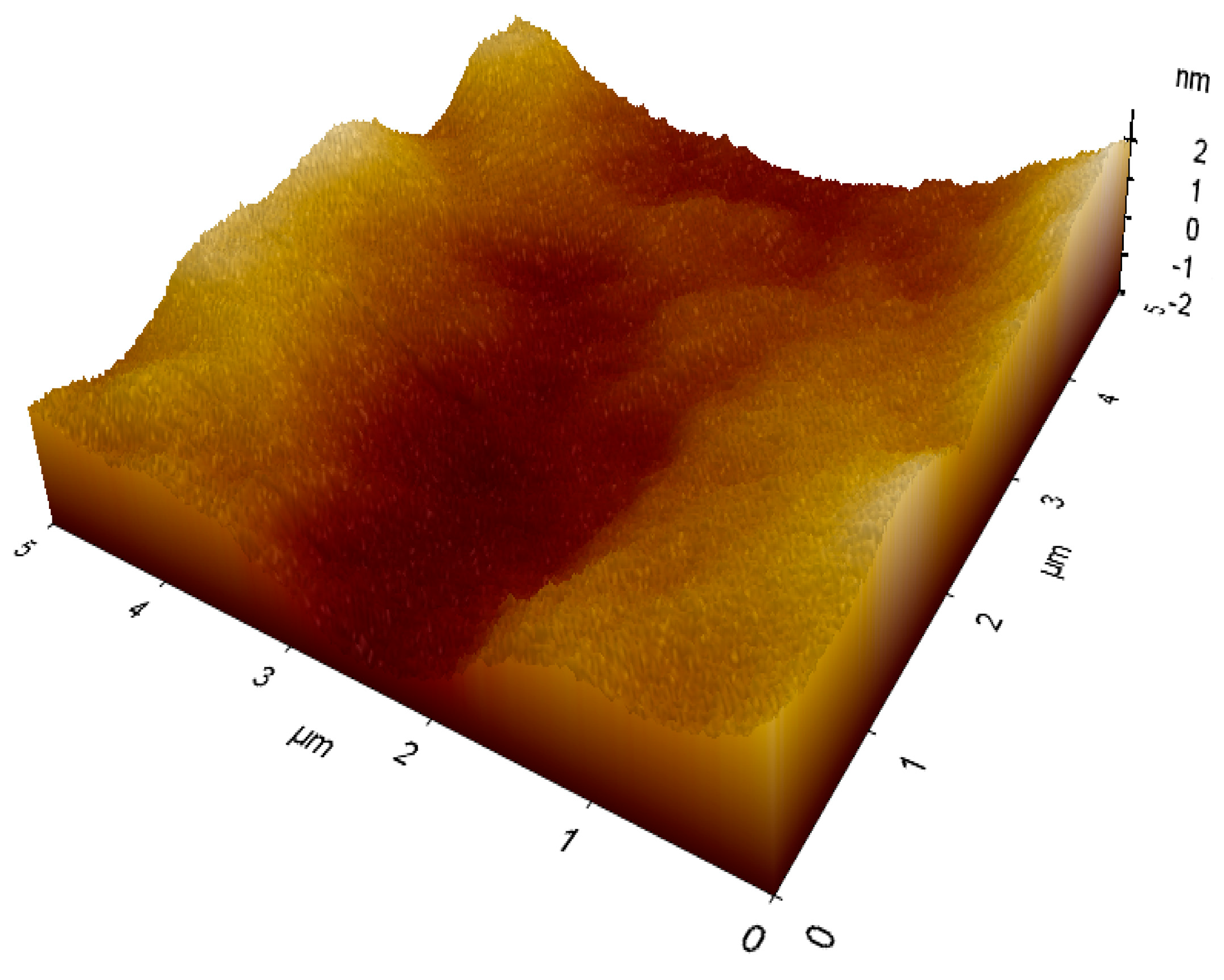
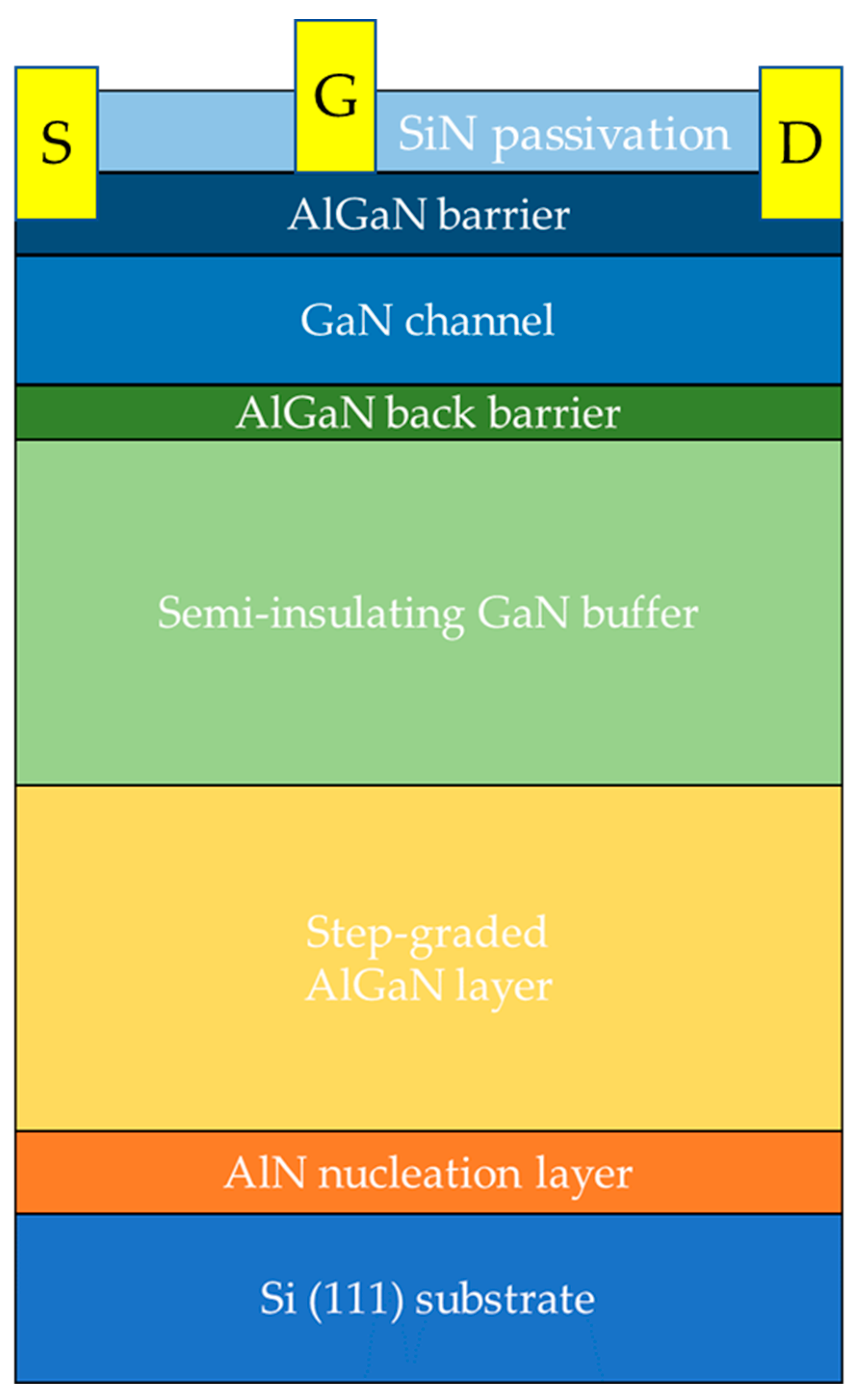
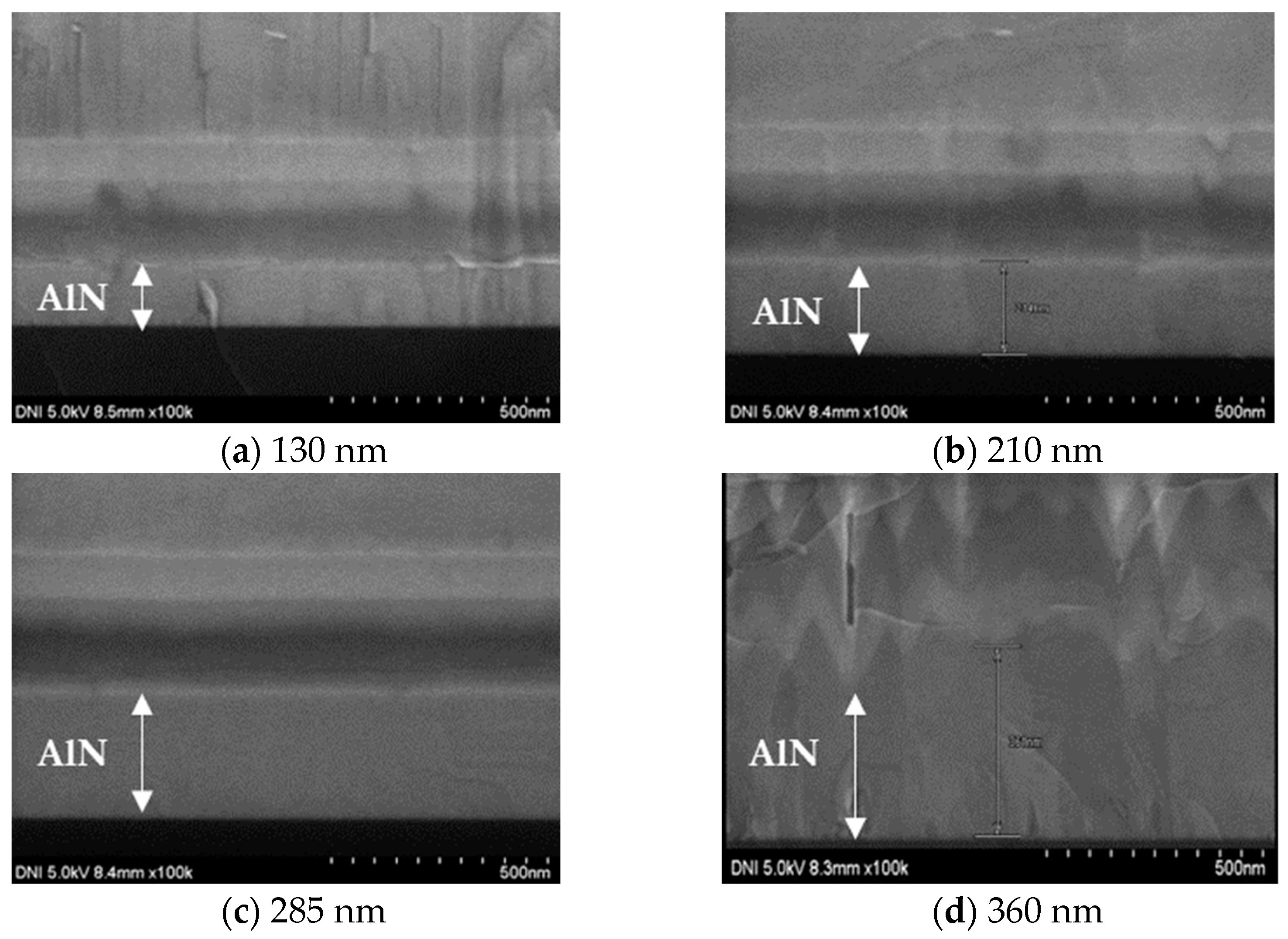
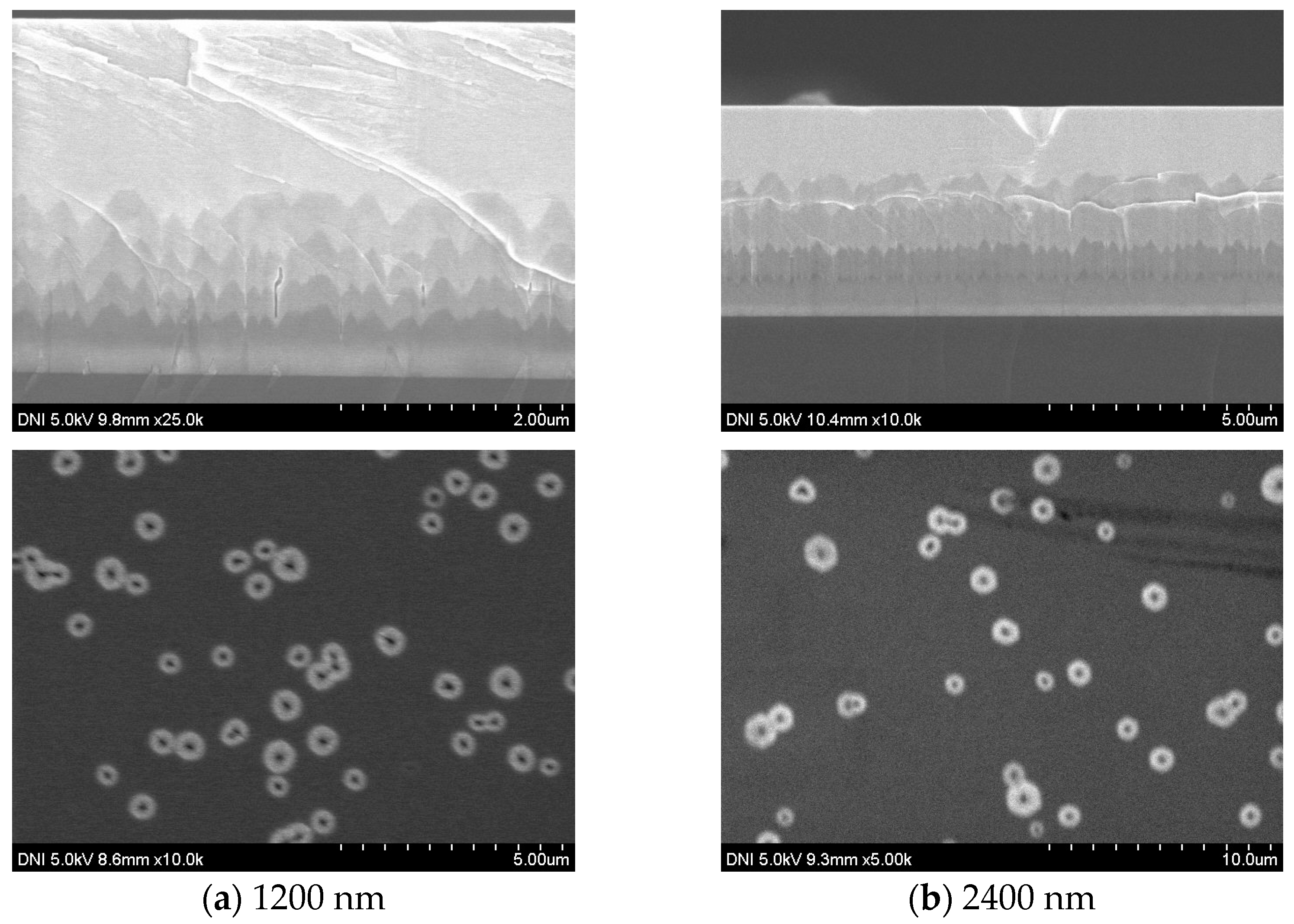
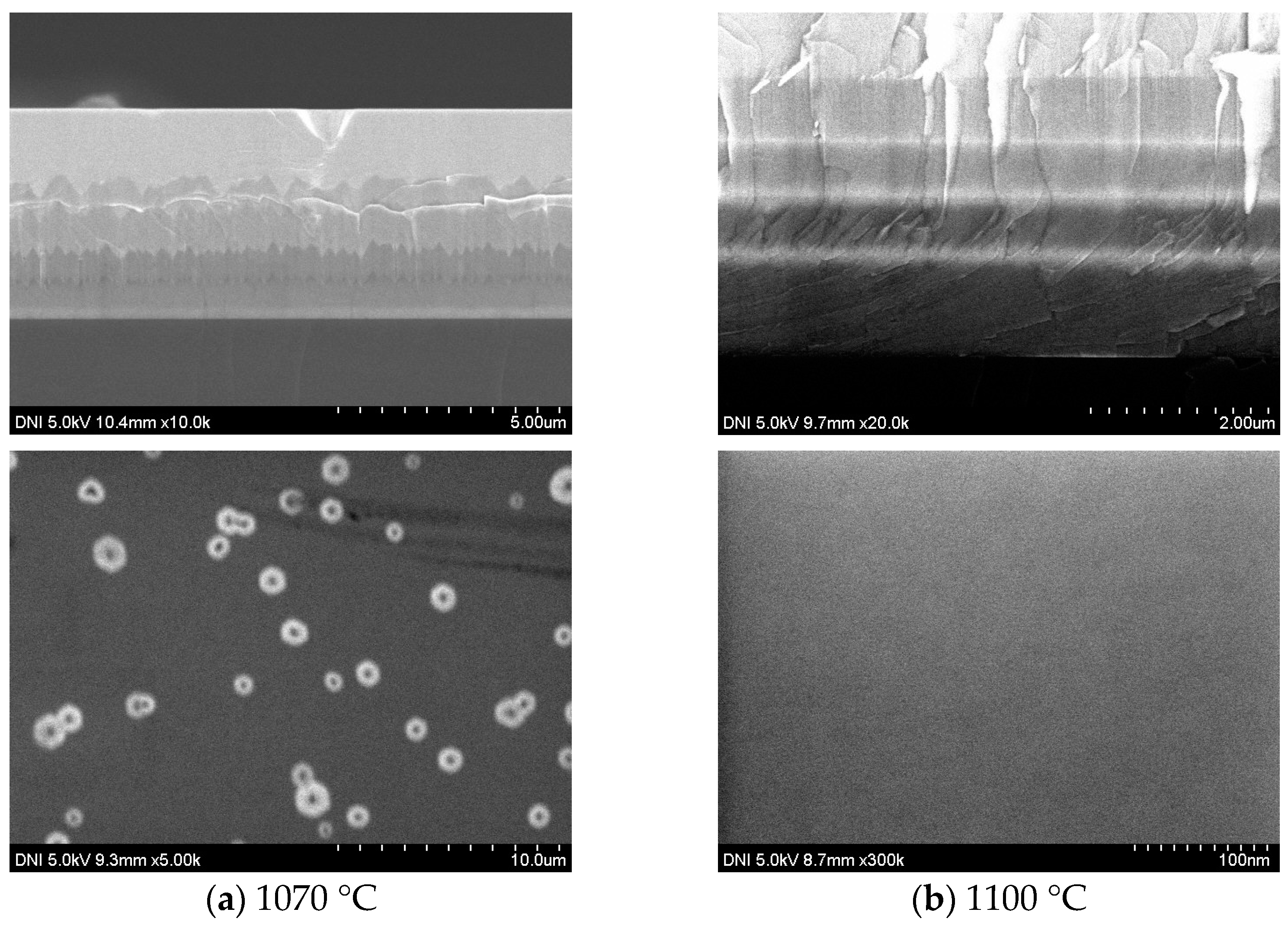
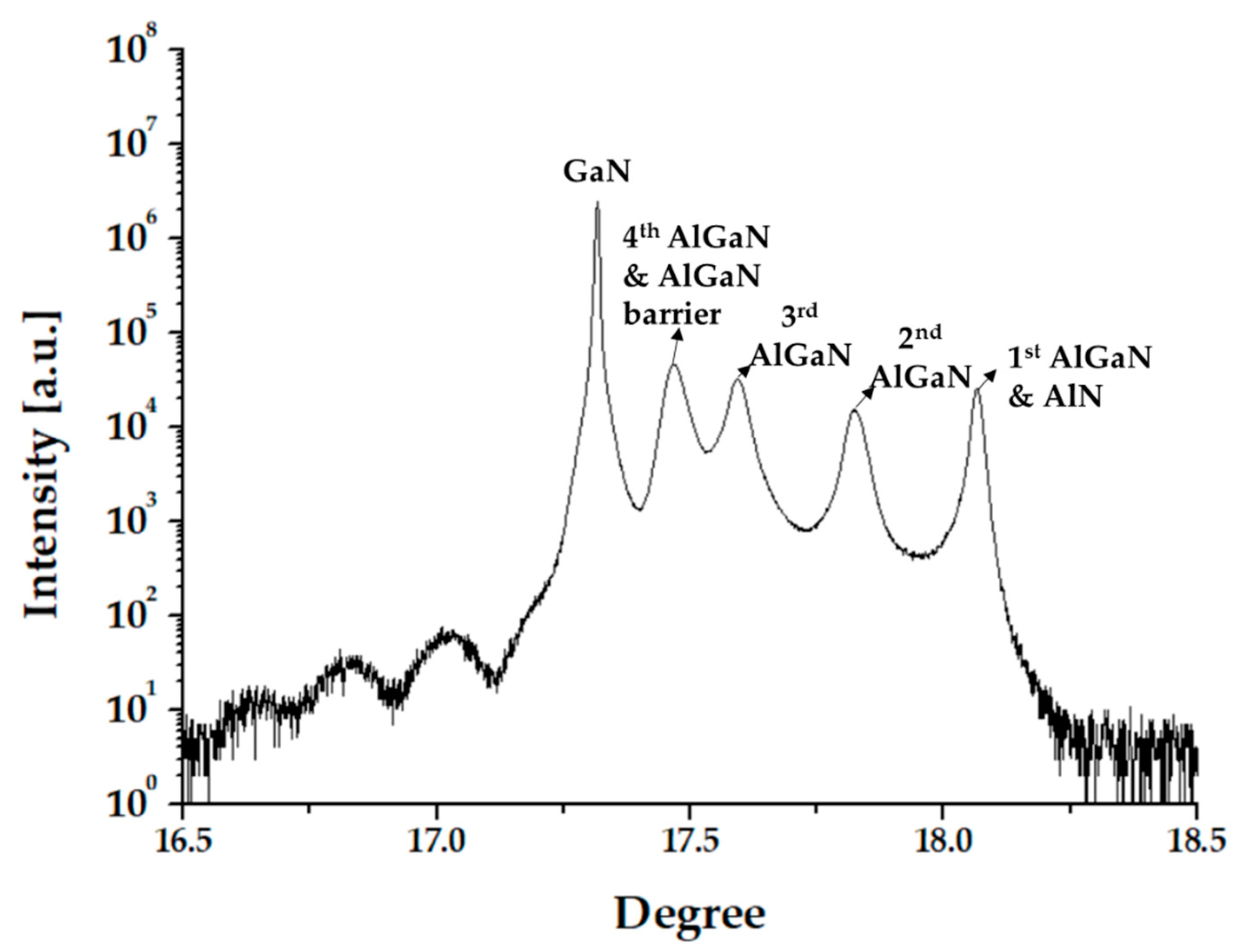
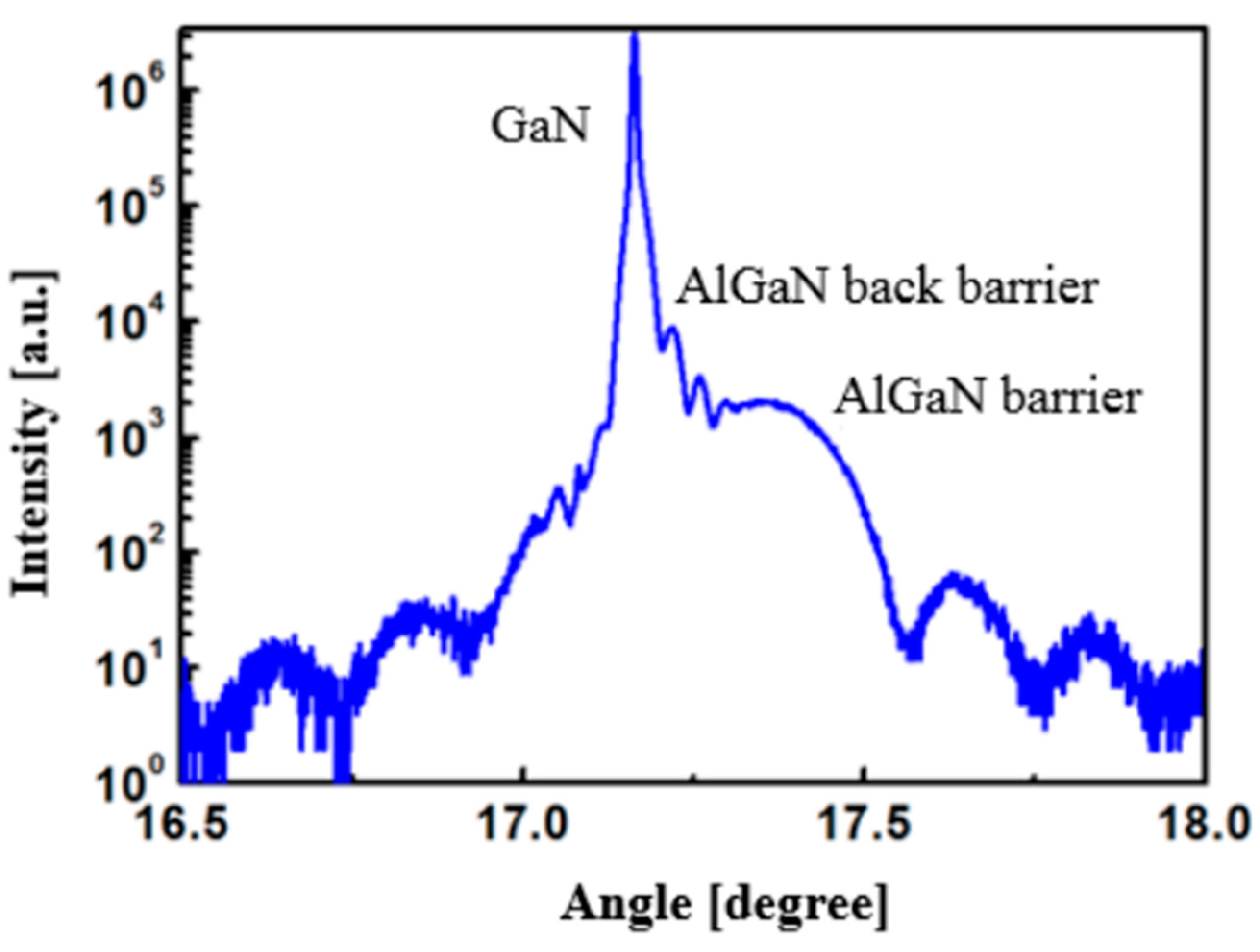
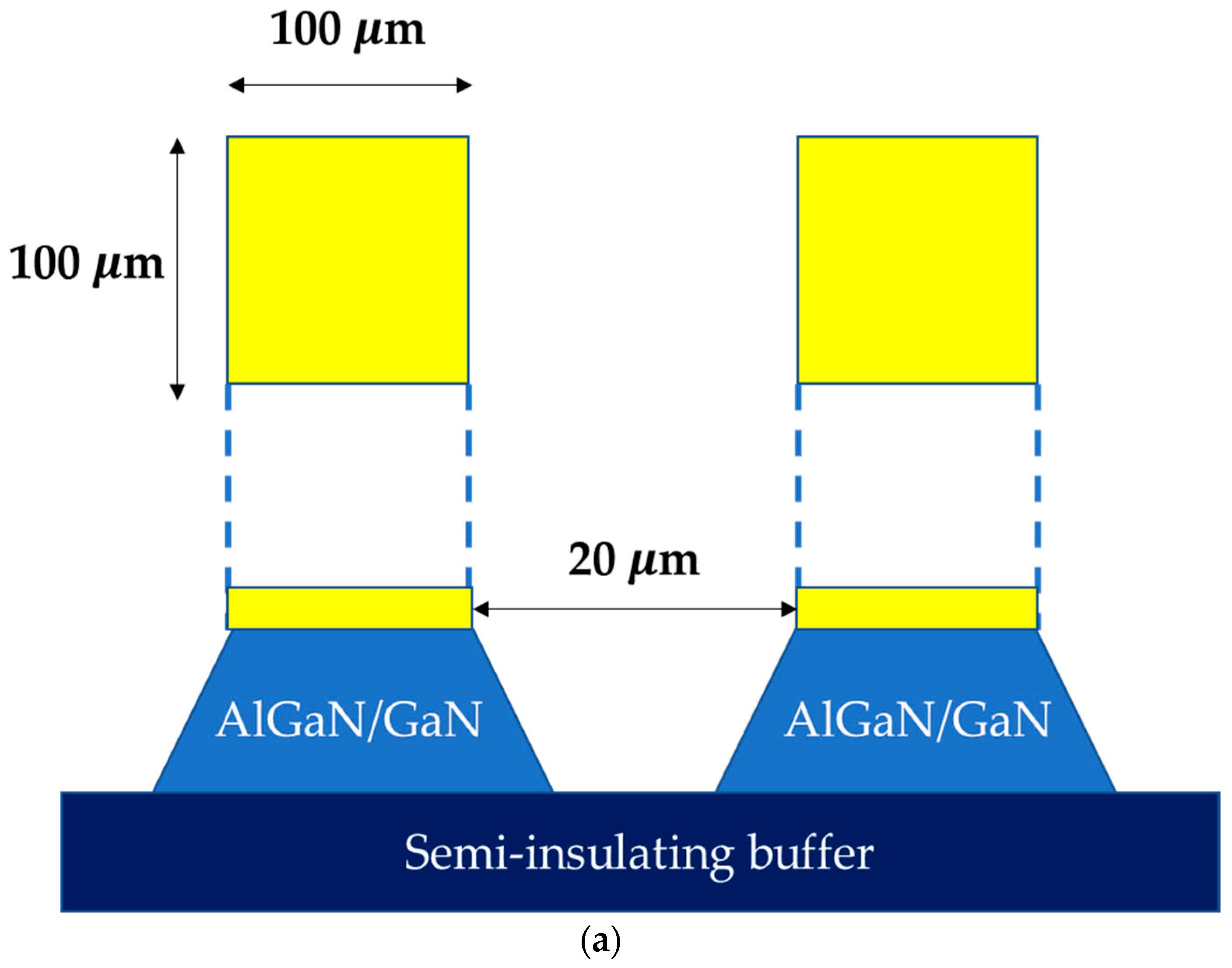
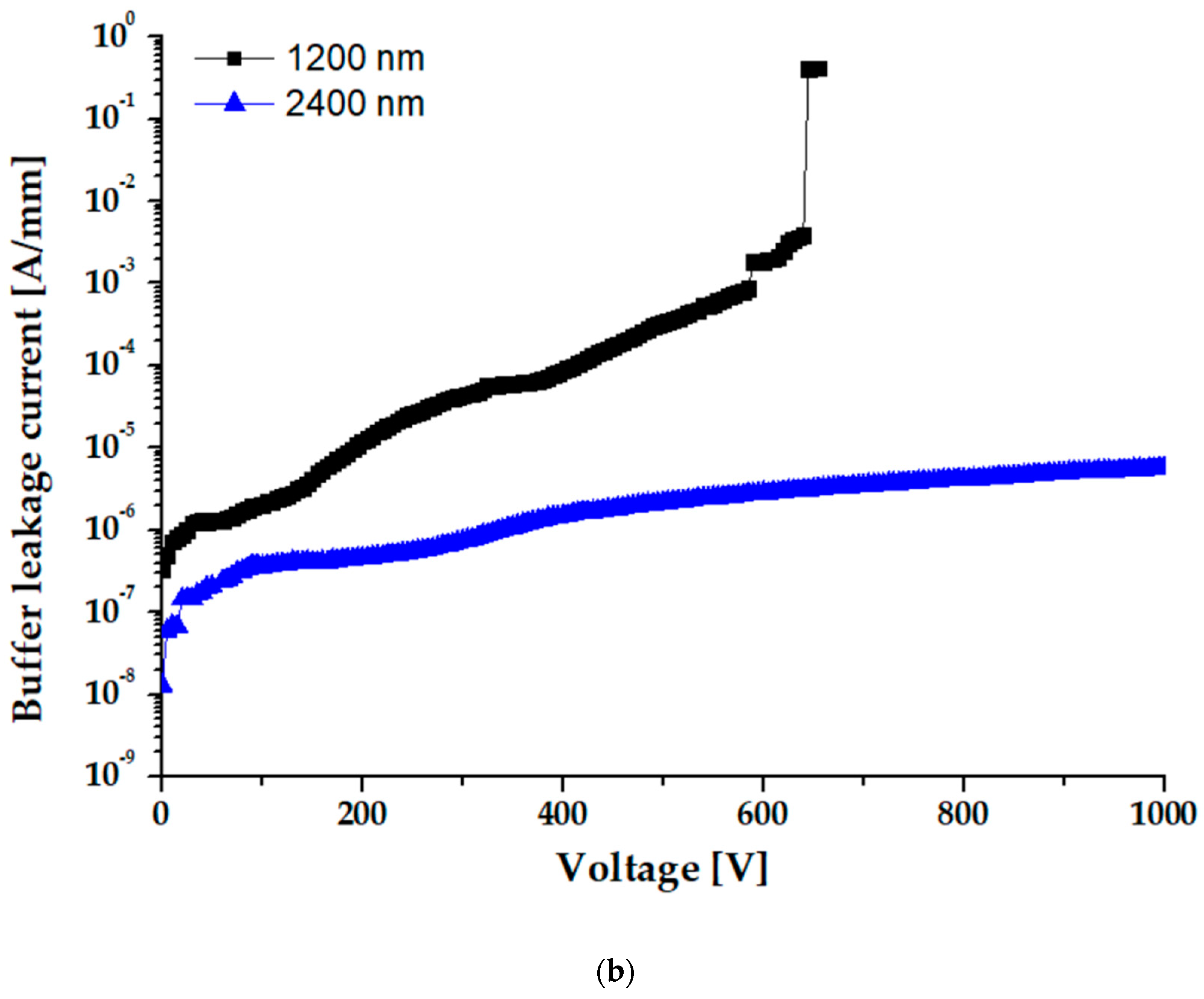
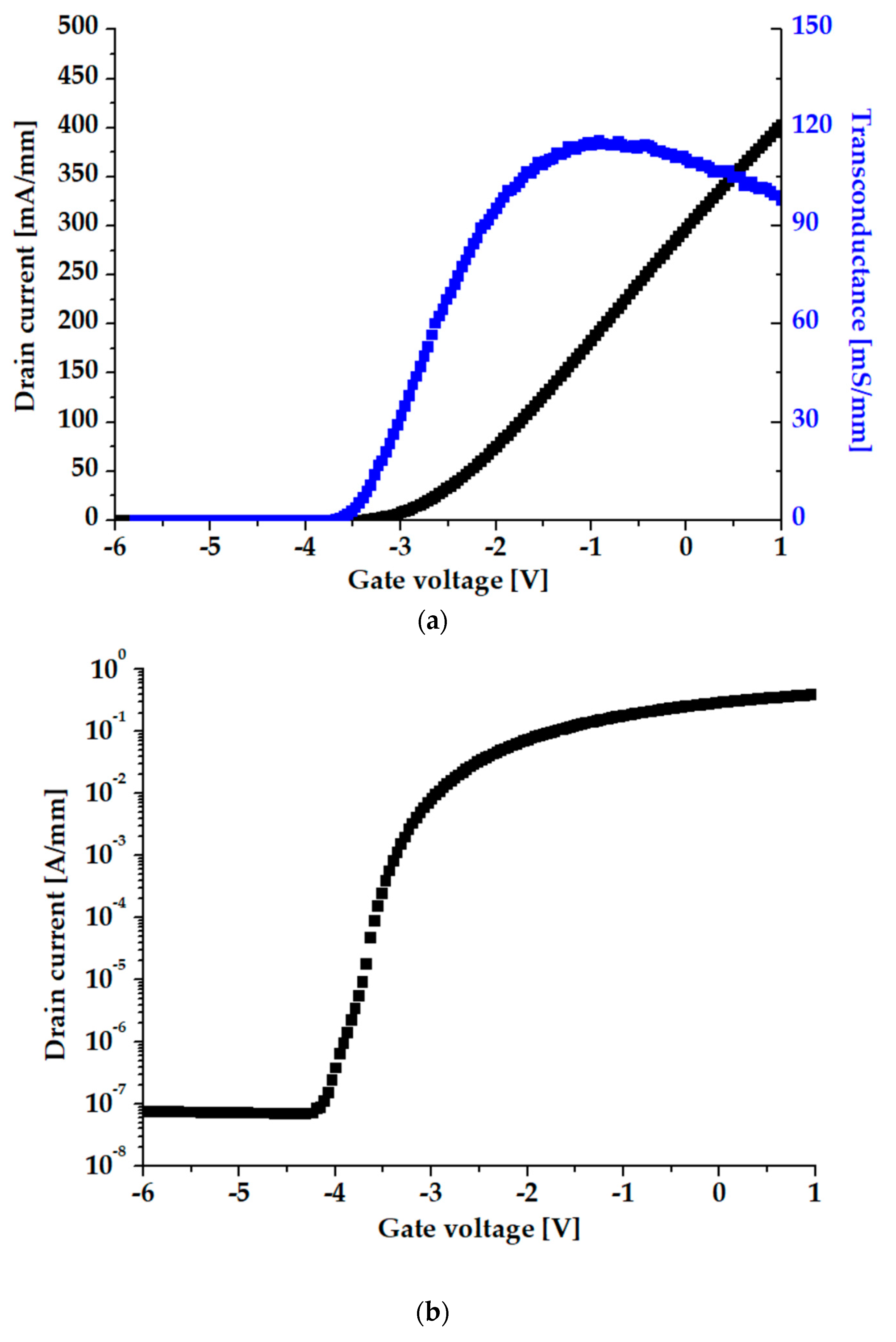
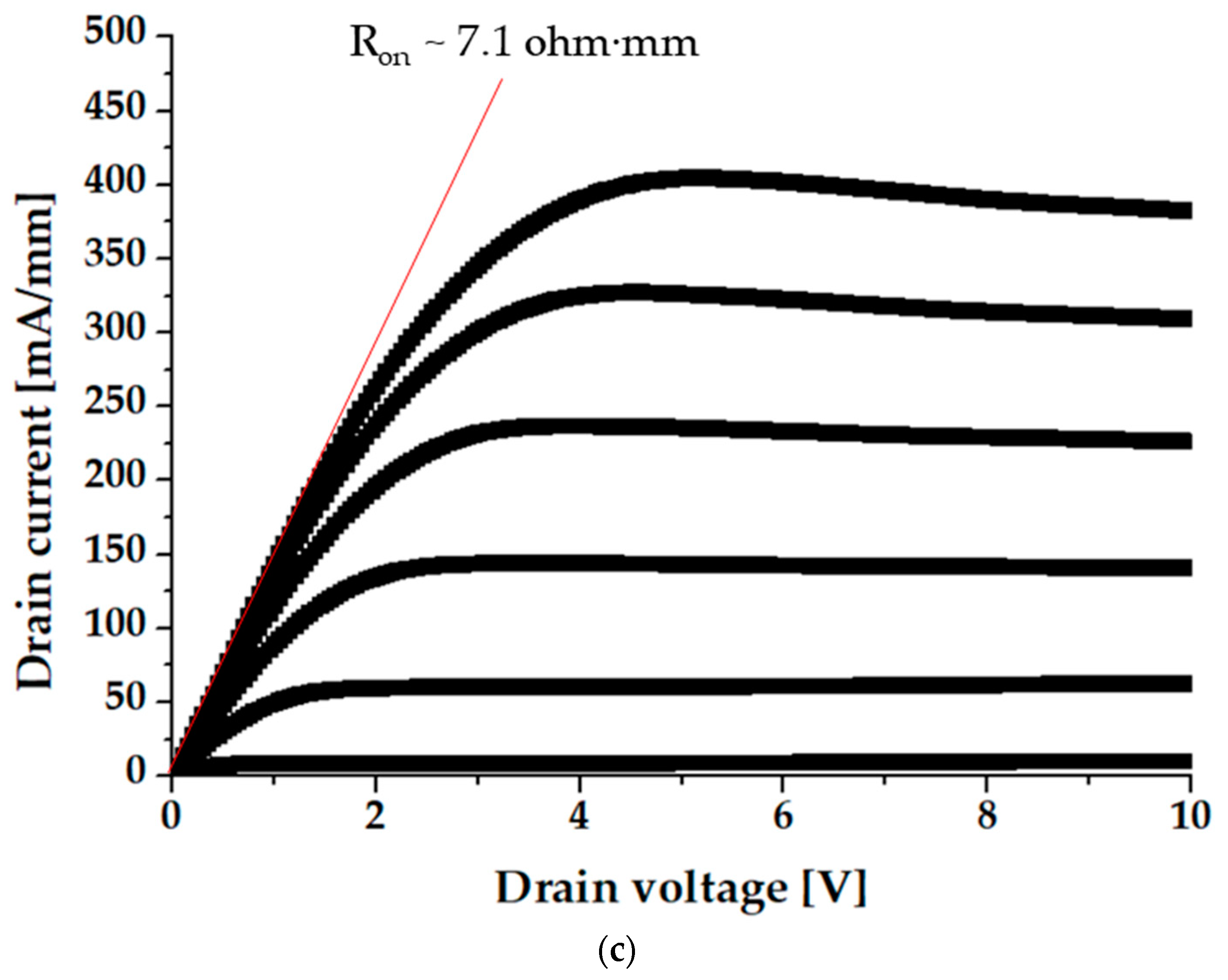
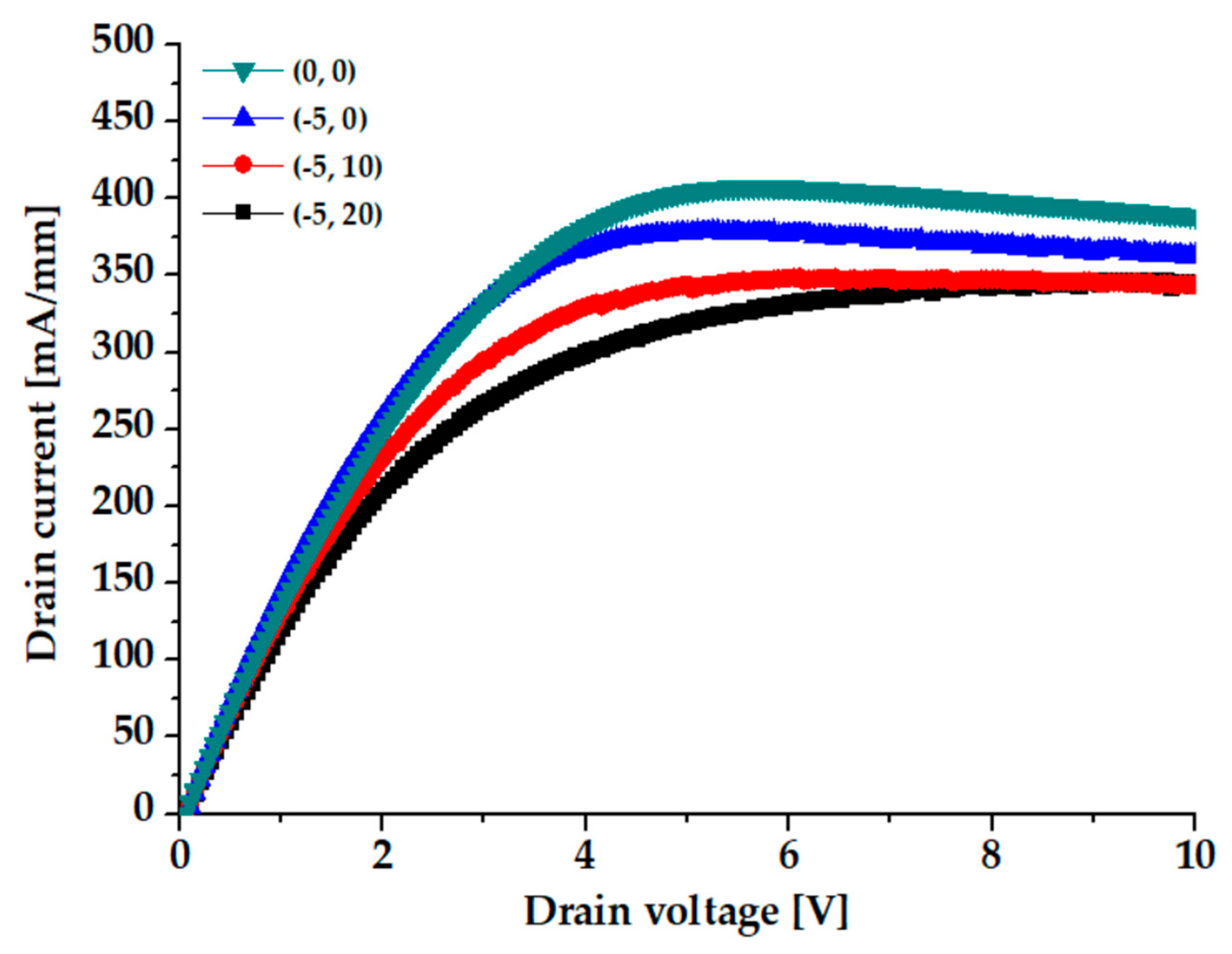
| 2-DEG Property | ||
|---|---|---|
| Electron Desity [cm−2] | Electron Mobility [cm2/V·s] | Sheet Resistance [ohm/sq] |
| 8.91 × 1012 | 1600 | 429.9 |
| Position | Al Composition [%] | Thickness [nm] |
|---|---|---|
| 1st AlGaN layer | 95.0 | 651 |
| 2nd AlGaN layer | 78.1 | 582 |
| 3rd AlGaN layer | 42.7 | 563 |
| 4th AlGaN layer | 23.8 | 637 |
Disclaimer/Publisher’s Note: The statements, opinions and data contained in all publications are solely those of the individual author(s) and contributor(s) and not of MDPI and/or the editor(s). MDPI and/or the editor(s) disclaim responsibility for any injury to people or property resulting from any ideas, methods, instructions or products referred to in the content. |
© 2024 by the author. Licensee MDPI, Basel, Switzerland. This article is an open access article distributed under the terms and conditions of the Creative Commons Attribution (CC BY) license (https://creativecommons.org/licenses/by/4.0/).
Share and Cite
Kim, J.-G. Optimization of Epitaxial Structures on GaN-on-Si(111) HEMTs with Step-Graded AlGaN Buffer Layer and AlGaN Back Barrier. Coatings 2024, 14, 700. https://doi.org/10.3390/coatings14060700
Kim J-G. Optimization of Epitaxial Structures on GaN-on-Si(111) HEMTs with Step-Graded AlGaN Buffer Layer and AlGaN Back Barrier. Coatings. 2024; 14(6):700. https://doi.org/10.3390/coatings14060700
Chicago/Turabian StyleKim, Jeong-Gil. 2024. "Optimization of Epitaxial Structures on GaN-on-Si(111) HEMTs with Step-Graded AlGaN Buffer Layer and AlGaN Back Barrier" Coatings 14, no. 6: 700. https://doi.org/10.3390/coatings14060700
APA StyleKim, J.-G. (2024). Optimization of Epitaxial Structures on GaN-on-Si(111) HEMTs with Step-Graded AlGaN Buffer Layer and AlGaN Back Barrier. Coatings, 14(6), 700. https://doi.org/10.3390/coatings14060700





